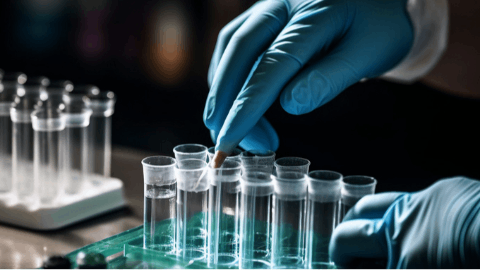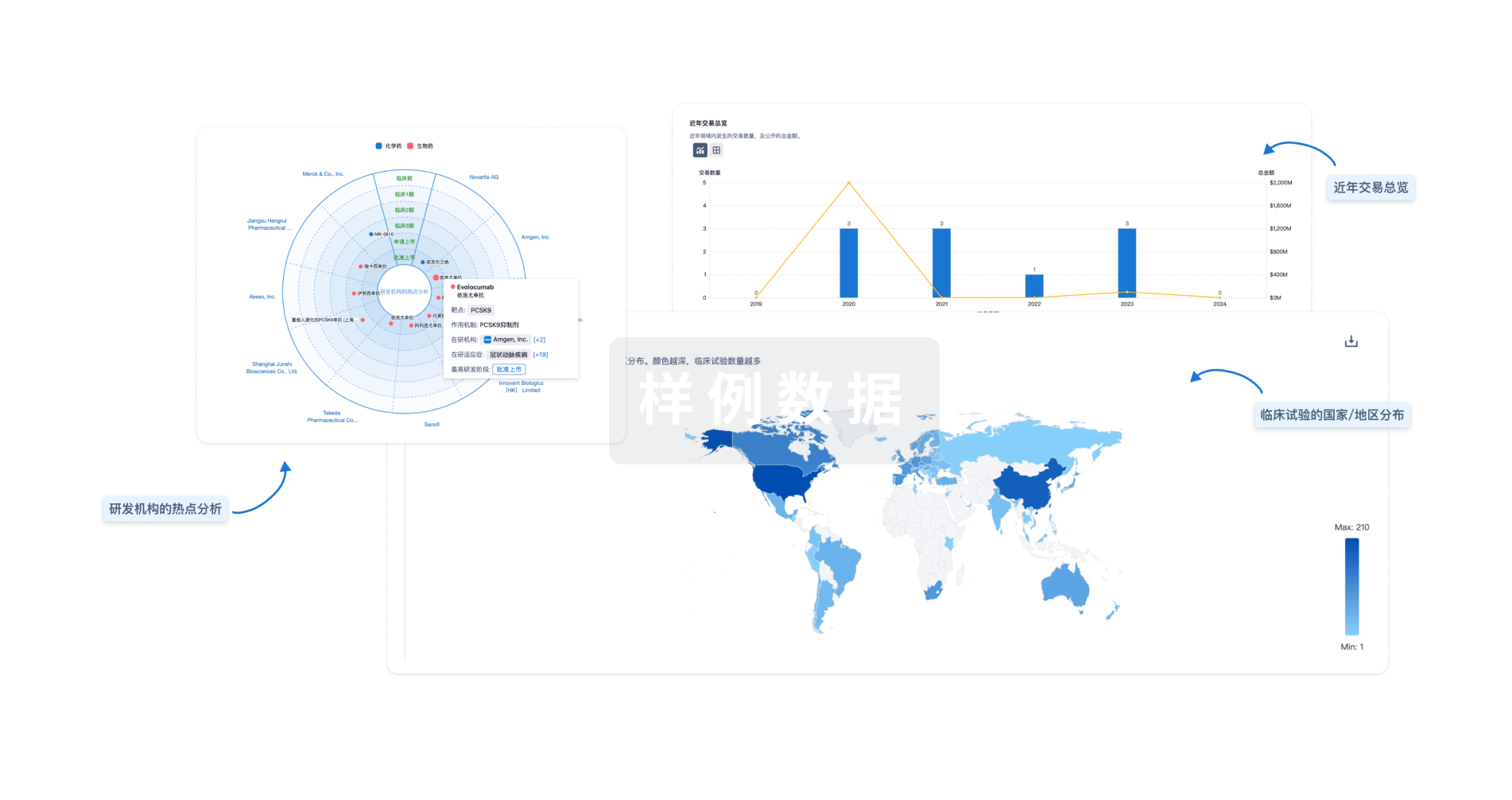预约演示
更新于:2025-05-07
PARG
更新于:2025-05-07
基本信息
别名 PARG、poly(ADP-ribose) glycohydrolase |
简介 Poly(ADP-ribose) glycohydrolase that degrades poly(ADP-ribose) by hydrolyzing the ribose-ribose bonds present in poly(ADP-ribose) (PubMed:15450800, PubMed:21892188, PubMed:23102699, PubMed:23474714, PubMed:33186521, PubMed:34019811, PubMed:34321462). PARG acts both as an endo- and exoglycosidase, releasing poly(ADP-ribose) of different length as well as ADP-ribose monomers (PubMed:23102699, PubMed:23481255). It is however unable to cleave the ester bond between the terminal ADP-ribose and ADP-ribosylated residues, leaving proteins that are mono-ADP-ribosylated (PubMed:21892188, PubMed:23474714, PubMed:33186521). Poly(ADP-ribose) is synthesized after DNA damage is only present transiently and is rapidly degraded by PARG (PubMed:23102699, PubMed:34019811). Required to prevent detrimental accumulation of poly(ADP-ribose) upon prolonged replicative stress, while it is not required for recovery from transient replicative stress (PubMed:24906880). Responsible for the prevalence of mono-ADP-ribosylated proteins in cells, thanks to its ability to degrade poly(ADP-ribose) without cleaving the terminal protein-ribose bond (PubMed:33186521). Required for retinoid acid-dependent gene transactivation, probably by removing poly(ADP-ribose) from histone demethylase KDM4D, allowing chromatin derepression at RAR-dependent gene promoters (PubMed:23102699). Involved in the synthesis of ATP in the nucleus, together with PARP1, NMNAT1 and NUDT5 (PubMed:27257257). Nuclear ATP generation is required for extensive chromatin remodeling events that are energy-consuming (PubMed:27257257). |
关联
24
项与 PARG 相关的药物靶点 |
作用机制 PARG抑制剂 |
在研机构 |
原研机构 |
非在研适应症- |
最高研发阶段临床1期 |
首次获批国家/地区- |
首次获批日期1800-01-20 |
靶点 |
作用机制 PARG抑制剂 |
在研机构 |
原研机构 |
非在研适应症 |
最高研发阶段临床1期 |
首次获批国家/地区- |
首次获批日期1800-01-20 |
靶点 |
作用机制 PARG抑制剂 |
在研机构 |
非在研适应症- |
最高研发阶段临床1期 |
首次获批国家/地区- |
首次获批日期1800-01-20 |
5
项与 PARG 相关的临床试验NCT06614751
A Phase I, Open-label, Dose Escalation and Dose Expansion Study to Evaluate the Safety, Tolerability, Pharmacokinetics, Pharmacodynamics and Preliminary Efficacy of DAT-2645 in Patients with Advanced/Metastatic Solid Tumors Harboring BRCA1/2 Loss of Function Alterations And/or Other Defects in the DNA Damage Repair Pathway
The primary objective of the study is to evaluate the safety, tolerability, PK, PD, and prilimary efficacy of a PARG inhibitor DAT-2645 in patients with advanced/metastatic solid tumors harboring BRCA1/2 loss of function alterations and/or other defects in the DNA damage repair (DDR) pathway.
开始日期2024-11-01 |
申办/合作机构 |
NCT06395519
A Study of PARG Inhibitor ETX-19477 in Patients With Advanced Solid Malignancies
This is a two-part, open-label, multicenter, dose escalation and dose expansion study designed to evaluate the safety, tolerability, pharmacokinetics (PK), pharmacodynamics (PDx), and anti- tumor activity of ETX-19477, a novel reversible small molecule inhibitor of PARG.
开始日期2024-05-13 |
申办/合作机构 |
NCT05787587
A Study of PARG Inhibitor IDE161 in Participants With Advanced Solid Tumors
The purpose of this study is to characterize the safety, tolerability, and efficacy of IDE161 as a single agent and in combination with pembrolizumab.
开始日期2023-04-05 |
申办/合作机构 |
100 项与 PARG 相关的临床结果
登录后查看更多信息
100 项与 PARG 相关的转化医学
登录后查看更多信息
0 项与 PARG 相关的专利(医药)
登录后查看更多信息
624
项与 PARG 相关的文献(医药)2025-09-01·Biomaterials
Mucus-penetrating nanomotor system strengthens mucosal immune response to in situ bacterial vaccine against severe bacterial pneumonia
Article
作者: Guo, Zhong ; Li, Nan ; Huang, Linghong ; Liu, Zonghua ; Zuo, Qinhua ; Song, Ting
2025-08-01·Bioorganic & Medicinal Chemistry
Recent advances in the synthesis of poly (ADP-ribose)
Review
作者: Tang, Li ; Wu, Yidan ; Liu, Qiang
2025-05-01·Molecular Carcinogenesis
Integrated Genomics Reveal Potential Resistance Mechanisms of PANoptosis‐Associated Genes in Acute Myeloid Leukemia
Article
作者: Liang, Cong ; Chen, Mengke ; Lei, Mengjie ; Long, Zhiqing ; Ding, Ran
83
项与 PARG 相关的新闻(医药)2025-03-26
4 IDEAYA/GSK presentations of IDE275 (GSK959) and 4 additional presentations across IDE397/MAT2A, IDE161/PARG, PRMT5, and KAT6/7 programs at AACR 2025
IDE275 (GSK959) has demonstrated a potential best-in-class preclinical profile in the MSI-H setting, with a unique binding mode from previously reported WRN inhibitors
Phase 1 dose escalation trial ongoing in MSI-H solid tumors with GSK
MSI-H prevalence has been reported at approximately 31%, 20%, and 19% in endometrial, colorectal, and gastric cancers, respectively
SOUTH SAN FRANCISCO, Calif., March 26, 2025 /PRNewswire/ -- IDEAYA Biosciences, Inc. (Nasdaq: IDYA), a leading precision medicine oncology company, today announced the publication of abstracts for an oral presentation in the New Drugs on the Horizon series, and three poster presentations on IDE275 (GSK959) at the American Association for Cancer Research (AACR) Annual Meeting, taking place April 25-30, 2025, in Chicago, Illinois. IDE275 (GSK959), a potential best-in-class Werner Helicase (WRN) inhibitor, has demonstrated selective preclinical efficacy in the high microsatellite instability (MSI-H) solid tumor setting, and is advancing in a Phase 1 dose escalation trial in partnership with GSK.
"IDE275 (GSK959) has a potential best-in-class profile and the preclinical data to be presented at AACR 2025 with GSK highlights the molecule's selectivity to treat MSI-H solid tumors and potential to be developed clinically as both a monotherapy agent and in combination with PD1," said Yujiro S. Hata, President and Chief Executive Officer, IDEAYA Biosciences. "MSI-H represents a meaningful biomarker-defined population with double-digit percent prevalence observed in multiple solid tumor types, including endometrial, colorectal, and gastric cancers. By binding uniquely to the helicase domain of WRN, IDE275 (GSK959) delivers potent and selective inhibition across MSI-H models," said Michael White, Ph.D., Chief Scientific Officer, IDEAYA Biosciences.
IDE275 (GSK959) was discovered through a collaboration between IDEAYA and GSK. Preclinical studies have demonstrated IDE275's (GSK959) potential as a best-in-class WRN inhibitor, inducing single-agent tumor regressions in MSI-H patient-derived xenograft (PDX) and cell line-derived xenograft (CDX) models for endometrial, colorectal, and gastric cancers. Notably, MSI-H prevalence in these cancers has been reported at approximately 31%, 20%, and 19%, respectively, underscoring the significant patient population that could benefit from this therapeutic approach.
As part of the collaboration, GSK is responsible for 80% of global research and development costs for IDE275 (GSK959), and IDEAYA is responsible for 20% of such costs. GSK holds a global, exclusive license to develop and commercialize IDE275 (GSK959). IDEAYA has the potential to earn a $10.0 million milestone payment upon initiation of Phase 1 clinical dose expansion. Additionally, IDEAYA is eligible to receive up to $465 million in future late-stage development and regulatory milestone payments. Upon commercialization, IDEAYA will be eligible to receive up to $475.0 million of commercial milestones, 50% of U.S. net profits and tiered royalties on global non-U.S. net sales of the IDE275 (GSK959) – ranging from high single-digit to sub-teen double-digit percentages, subject to certain customary reductions.
At AACR 2025, IDEAYA will have 8 total presentations across 3 clinical and 2 pre-clinical programs. There will be 4 IDEAYA/GSK presentations of IDE275 (GSK959) and 4 additional presentations across the IDE397/MAT2A, IDE161/PARG, PRMT5, and KAT6/7 programs.
Details for the oral presentation are as follows:
Presenter: Dr. Yanhua Rao, GSK
Title: An innovative and reversible WRN helicase inhibitor, GSK4418959 (IDE275), emerges as a promising clinical candidate for MSI-H cancers
Session: New Drugs on the Horizon Session, Part 3 (DDT003)
Date and Time: Monday, April 28, 2025 at 10:40am CDT
Location: Room S406 (Vista Ballroom) - McCormick Place South (Level 4)
Poster presentation details are below:
Author: Rao, Y. et al.
Title: Patient selection, target engagement and pharmacodynamic markers of WRN inhibitor GSK4418959 (IDE275)
Poster Number: 6393/30
Session Title: Pharmacokinetics and Pharmacodynamics of Cancer Therapeutics
Date and Time: Tuesday, April 29, 2025 at 9:00am – 12:00pm CDT
Author: Lee, Y. et al.
Title: Preclinical Characterization of GSK4418959 (IDE275): A Potent, Selective, and Highly Efficacious WRN Inhibitor for MSI-H Tumors Across Multiple Cancer Types
Poster Number: 2913/20
Session Title: DNA Damage Response and Modulation of DNA Repair 1
Date and Time: Monday, April 28, 2025 at 2:00pm – 5:00pm CDT
Author: Taygerly, P. et al.
Title: Discovery of GSK4418959 (IDE275): A novel, non-covalent, reversible Werner Helicase inhibitor and a new potential therapeutic for the treatment of MSI-H cancers
Poster Number: 5750/50
Session Title: Drug Design, Synthesis, & Disposition
Date and Time: Tuesday, April 29, 2025 at 2:00pm CDT
Author: Gupta, M. et al.
Title: Dual KAT6/7 inhibition disrupts epigenetic programs that promote tumor evolution and adaptive drug resistance
Poster Number: 442/3
Session Title: Epigenetic Targets
Date and Time: Sunday, April 27, 2025 at 2:00pm – 5:00pm CDT
Author: Maskey, R. et al.
Title: PARG inhibition provokes a DNA damage-dependent innate immune reaction that enhances ICI-driven anti-tumor immunity
Poster Number: 2899/6
Session Title: DNA Damage Response and Modulation of DNA Repair 1
Date and Time: Monday, April 28, 2025 at 2:00pm – 5:00pm CDT
Author: Garbett, D. et al.
Title: The allosteric MAT2A inhibitor IDE397 uniquely exploits metabolic liabilities associated with MTAP deletion to perturb DNA replication and repair
Poster Number: 4268/25
Session Title: New and Emerging Cancer Drug Targets
Date and Time: Tuesday, April 29, 2025 at 9:00am – 12:00pm CDT
Author: Aubi, O. et al.
Title: The impact of metabolite kinetics on dysregulation of essential enzymes in cancers with MTAP deficiencies
Poster Number: 4504/15
Session Title: Proteomic Biomarkers and Therapeutics
Date and Time: Tuesday, April 29, 2025 at 9:00am – 12:00pm CDT
The oral presentation and posters will be available online at following the presentations.
About IDEAYA Biosciences
IDEAYA is a precision medicine oncology company committed to the discovery and development of targeted therapeutics for patient populations selected using molecular diagnostics. IDEAYA's approach integrates capabilities in identifying and validating translational biomarkers with drug discovery to select patient populations most likely to benefit from its targeted therapies. IDEAYA is applying its research and drug discovery capabilities to synthetic lethality – which represents an emerging class of precision medicine targets.
Forward-Looking Statements
This press release contains forward-looking statements, including, but not limited to, statements related to i) the publication of abstracts and oral and poster presentations on various drug programs; ii) the potential therapeutic benefit of IDE275; iii) the potential patient population that could benefit from IDE275; and iv) the potential for Ideaya to receive development and commercialization milestone payments and subsequent profits and royalties on net sales of IDE275. Such forward-looking statements involve substantial risks and uncertainties that could cause IDEAYA's preclinical and clinical development programs, future results, performance or achievements to differ significantly from those expressed or implied by the forward-looking statements. Such risks and uncertainties include, among others, the uncertainties inherent in the drug development process, including IDEAYA's programs' early stage of development, the process of designing and conducting preclinical and clinical trials, the regulatory approval processes, the timing of regulatory filings, the challenges associated with manufacturing drug products, IDEAYA's ability to successfully establish, protect and defend its intellectual property, and other matters that could affect the sufficiency of existing cash to fund operations. IDEAYA undertakes no obligation to update or revise any forward-looking statements. For a further description of the risks and uncertainties that could cause actual results to differ from those expressed in these forward-looking statements, as well as risks relating to the business of IDEAYA in general, see IDEAYA's Annual Report on Form 10-K dated February 18, 2025 and any current and periodic reports filed with the U.S. Securities and Exchange Commission.
Investor and Media Contact
IDEAYA Biosciences
Andres Ruiz Briseno
Chief Accounting Officer
[email protected]
SOURCE IDEAYA Biosciences, Inc.
WANT YOUR COMPANY'S NEWS FEATURED ON PRNEWSWIRE.COM?
440k+
Newsrooms &
Influencers
9k+
Digital Media
Outlets
270k+
Journalists
Opted In
GET STARTED
临床1期引进/卖出AACR会议
2025-03-10
·创鉴汇
▎药明康德内容团队编辑
据创鉴汇不完全统计,上周(3月3日至3月9日)全球大健康领域共披露融资事件16起,总额近60亿元。按照金额划分,亿元及以上融资7起。按照已披露的融资轮次划分,早期融资(B轮以前)6起,中后期融资(B轮及以后)5起。生物医药领域共7家公司获融资,涉及药物类型包括抗体偶联药物、干细胞疗法、蛋白降解疗法等。
#01
Callio完成1.87亿美元A轮融资
关键词:抗体偶联药物
最新融资:1.87亿美元A轮
本轮投资机构:Frazier Life Sciences、Jeito Capital、Norwest Venture Partners、诺和控股、Omega Funds等
3月3日,Callio Therapeutics宣布成立并完成1.87亿美元A轮融资,由Frazier Life Sciences领投。Callio Therapeutics计划利用本轮融资将其HER2靶向双有效载荷ADC和第二个未披露的ADC项目推向临床阶段。此外,公司与Hummingbird Bioscience达成全球独家许可协议,以其多有效载荷ADC平台及相关知识产权作为互换条件。Callio Therapeutics总部位于西雅图和新加坡,正在开发下一代多有效载荷抗体偶联药物(ADC),采用差异化的有效载荷和接头技术,能够将多试剂靶向递送至肿瘤细胞,从而最大限度地提高治疗效果。Callio Therapeutics的主导项目是靶向HER2的双有效载荷ADC。
#02
Garuda完成5000万美元A1轮融资
关键词:干细胞疗法
最新融资:5000万美元A1轮
本轮投资机构:奥博资本、Kyowa Kirin、Northpond Ventures、鱼鹰资管
3月4日,Garuda Therapeutics宣布完成5000万美元A1轮融资。Garuda Therapeutics主要研发现货型造血干细胞(HSC)疗法,用于治疗各类血液病。Garuda Therapeutics的技术使自我更新的造血干细胞具有耐用性、与人类白细胞抗原(HLA)相容且无转基因的特点。Garuda Therapeutics的技术有机会解决多种独特的血液疾病并消除对供体血细胞的依赖。A1轮融资将支持Garuda的产品线进入临床,扩大公司内部生产规模以及一般运营活动。
#03
TRIMTECH完成3100万美元种子轮融资
关键词:蛋白降解疗法
最新融资:3100万美元种子轮
本轮投资机构:辉瑞风投、礼来公司、MP Healthcare Venture Management、M Ventures、Start Codon等
3月5日,TRIMTECH Therapeutics宣布完成了3100万美元种子轮融资。这家公司专注于使用靶向蛋白质降解技术(TPD)治疗神经退行性疾病。TRIMTECH Therapeutics正在利用E3泛素连接酶TRIM21的先天特性来选择性和有效地降解与一系列疾病相关的蛋白质聚集体,而目前的TPD疗法并不能很好地解决这些疾病。本轮融资将支持公司以TRIM21为基础的TRIMTAC聚集选择性降解分子的进一步研发,该研究重点关注治疗阿尔茨海默病和亨廷顿病等严重神经退行性和炎症性疾病的药物开发。
#04
丹擎医药完成1.5亿元新一轮融资
关键词:小分子药物
最新融资:1.5亿元
本轮投资机构:阿斯利康中金医疗产业基金、国方创新、红杉中国、康君资本、磐霖资本
3月3日,丹擎医药 (Danatlas Pharmaceuticals)宣布完成新一轮1.5亿元人民币融资。本次融资将用于加速核心管线的临床研究、拓展创新技术平台及全球化战略布局。丹擎医药自2021年成立以来,搭建了“合成致死”药物研发平台和转化医学平台。其核心产品PARG抑制剂(DAT-2645)已经获得中国NMPA和美国FDA批准开展临床1期研究,该产品正在中国开展临床1期的剂量递增研究,目前展示出良好的安全性、耐受性和抗肿瘤活性。同时,公司有多款创新候选药物研发管线推进至IND阶段。
读者们请星标⭐创鉴汇,第一时间收到推送
免责声明:药明康德内容团队专注介绍全球生物医药健康研究进展。本文仅作信息交流之目的,文中观点不代表药明康德立场,亦不代表药明康德支持或反对文中观点。本文也不是治疗方案推荐。如需获得治疗方案指导,请前往正规医院就诊。
版权说明:本文由药明康德内容团队根据公开资料整理编辑,欢迎个人转发至朋友圈,谢绝媒体或机构未经授权以任何形式转发/复制至其他平台。转发授权请在「创鉴汇」微信公众号留言联系我们。
更多数据内容推荐
点击“在看”,分享创鉴汇健康新动态
细胞疗法抗体药物偶联物
2025-03-03
·医药观澜
3月3日,丹擎医药 (“Danatlas Pharmaceuticals”)刚刚宣布完成新一轮1.5亿元人民币融资。本轮融资由康君资本领投,阿斯利康中金医疗产业基金、国方创新、磐霖资本等多家知名投资机构跟投,老股东红杉中国持续加注。根据新闻稿,本次融资将用于加速核心管线的临床研究、拓展创新技术平台及全球化战略布局。
丹擎医药自2021年成立以来,搭建了“合成致死”药物研发平台和转化医学平台。其核心产品PARG抑制剂(DAT-2645)已经获得中国NMPA和美国FDA批准开展临床1期研究,该产品正在中国开展临床1期的剂量递增研究,目前展示出良好的安全性、耐受性和抗肿瘤活性。同时,公司有多款创新候选药物研发管线推进至IND阶段。
据丹擎医药此前新闻稿介绍,DAT-2645的适应症包括乳腺癌、卵巢癌、胰腺癌、前列腺癌、子宫癌、胃癌、结直肠癌等多种常见癌症,并且有望拓展PARP抑制剂无效的适应症和解决PARP抑制剂耐药的痛点,具有潜在的“广谱治疗性”的临床应用前景。
除了DAT-2645,丹擎医药官网显示其管线中还包括了其他几款靶向“合成致死”靶点的新药,靶点包括了Polθ、WRN等等。
参考资料:
[1]丹擎医药完成1.5亿元融资,领跑新一代“合成致死”药物临床开发. Retrieved Mar 3,2025, From https://mp.weixin.qq.com/s/Sfh5RLBDIsmJvX2JAyAwmg
内容来源于网络,如有侵权,请联系删除。

临床申请
分析
对领域进行一次全面的分析。
登录
或

生物医药百科问答
全新生物医药AI Agent 覆盖科研全链路,让突破性发现快人一步
立即开始免费试用!
智慧芽新药情报库是智慧芽专为生命科学人士构建的基于AI的创新药情报平台,助您全方位提升您的研发与决策效率。
立即开始数据试用!
智慧芽新药库数据也通过智慧芽数据服务平台,以API或者数据包形式对外开放,助您更加充分利用智慧芽新药情报信息。
生物序列数据库
生物药研发创新
免费使用
化学结构数据库
小分子化药研发创新
免费使用


